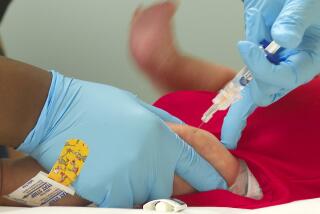Risky sexual behavior cited in rise of 3 diseases
- Share via
The number of newly diagnosed cases of the three most common sexually transmitted diseases rose for the second year in a row in the U.S., driven in part by an increase in risky sexual behavior, the Centers for Disease Control and Prevention reported Tuesday.
“Increases in all three of these STDs. . . underscore the need for vigilance,” said Dr. John M. Douglas Jr., director of the CDC’s division of STD prevention, which produced the report.
New cases of chlamydia, the most commonly reported infectious disease in 2006, were diagnosed at nearly three times the rate of gonorrhea, the second most commonly reported infectious disease, Douglas said.
“We believe since it’s underreported, it probably represents a much bigger iceberg,” he said.
Douglas said he was also worried about syphilis because “it was really primed for being eliminated, and we’ve seen reversals in what ought to be a preventable problem.”
Officials are still analyzing why the STD rates are going up, but they believe the rise is related to insufficient public health funds, increased testing and a resurgence of risky sexual behavior in some groups.
Of particular concern is a rising number of syphilis cases among gay and bisexual men, Douglas said. A large proportion of these men were HIV positive and became more sexually active when better AIDS drugs improved their health, he said.
Earlier this year, CDC officials said methamphetamine use, which often leads to riskier sexual behavior, had probably added to gonorrhea cases in the Western United States.
Dr. Gil Chavez, deputy director of the Center for Infectious Disease at the California Department of Public Health, said he believed that the drug may be driving up rates of other sexually transmitted diseases as well.
The CDC estimates that about 19 million Americans a year are infected with an STD.
Condom use decreases the risk for chlamydia, gonorrhea and syphilis, which are bacterial infections that can be treated with antibiotics.
According to the report, cases of chlamydia continued their steady long-term rise, increasing to about 348 cases per 100,000 people in 2006.
Gonorrhea infections rose 5.5% in 2006 to nearly 121 new cases per 100,000 people. The number of new cases had been declining for about two decades when they began leveling off in the late 1990s. Gonorrhea cases started to rise again in 2005.
Syphilis cases increased about 12% from 2005 to 2006, to about 13 new cases per 100,000 people.
CDC officials have been particularly interested in cases of primary and secondary syphilis, the earliest and most infectious stage of the disease.
The rates of early syphilis had been going down since 1991, but began increasing in 2001. In five years, the rate jumped from 2.1 new cases to 3.3 cases per 100,000 people.
Gay and bisexual men made up 64% of new cases of primary and secondary syphilis in 2006.






